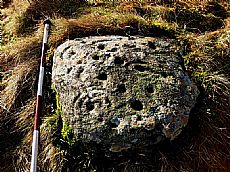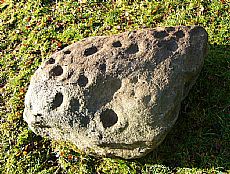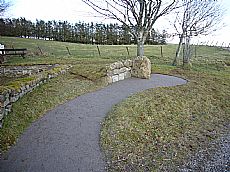Heights of Fodderty cup and ring marked stone
27 February 2014
- News Type:
- Find of the Month
 In 2006 Susan Kruse of ARCH discovered a fine cup and ring marked stone on the Heights of Fodderty between Dingwall and Strathpeffer. The stone has fine cup and ring mark decoration pecked into its surface. It was created in the Neolithic or Bronze Age by hammering and grinding with another stone to create an abstract pattern of small depressions, some surrounded by rings. When moving the stone to a new location at the Heights of Brae Neil Gunn Viewpoint, more cup and ring mark decoration was discovered on the reverse side.
In 2006 Susan Kruse of ARCH discovered a fine cup and ring marked stone on the Heights of Fodderty between Dingwall and Strathpeffer. The stone has fine cup and ring mark decoration pecked into its surface. It was created in the Neolithic or Bronze Age by hammering and grinding with another stone to create an abstract pattern of small depressions, some surrounded by rings. When moving the stone to a new location at the Heights of Brae Neil Gunn Viewpoint, more cup and ring mark decoration was discovered on the reverse side.
 Finding cup and ring decoration on the opposite side has raised a number of tantalising questions. Was the decoration meant to be viewed from both sides or was one decorated side deliberately placed face down? Or perhaps was the stone carved at different times?
Finding cup and ring decoration on the opposite side has raised a number of tantalising questions. Was the decoration meant to be viewed from both sides or was one decorated side deliberately placed face down? Or perhaps was the stone carved at different times?
Although some stones are decorated on different faces, only a few other stones with decoration on opposite sides are known. But since most of the examples are very heavy or even on unmoveable boulders or outcrops, no one has looked at the reverse sides.
This stone is just one pointer to a substantial prehistoric population in this upland area. There is a cluster of rock art up on the Heights (including three other examples found by Susan Kruse and John Wombell), at least one Neolithic chambered burial cairn and a number of round houses probably dating to the Bronze and Iron Ages. The Heights of Brae hoard from c. 950-800, the largest surviving late Bronze Age gold find from Scotland, was found nearby.
 At some point, probably a couple hundred years ago when the area of the Heights was settled by new crofters, the stone was moved onto a dyke. More recently, the stone was under threat from new building, and the landowner agreed that it could be moved to another location. After obtaining official permission from Highland Council and Treasure Trove, John and Susan approached the Neil Gunn Trust to ask if they could provide a suitable home for the stone near the Neil Gunn Monument. The Neil Gunn Trustees offered a site on the opposite side of the car park to the Signature Stone at Heights of Brae. The stone has now been moved to the Viewpoint and will be one of the few accessible by wheelchair. It has been re-erected on end to display both decorated sides.
At some point, probably a couple hundred years ago when the area of the Heights was settled by new crofters, the stone was moved onto a dyke. More recently, the stone was under threat from new building, and the landowner agreed that it could be moved to another location. After obtaining official permission from Highland Council and Treasure Trove, John and Susan approached the Neil Gunn Trust to ask if they could provide a suitable home for the stone near the Neil Gunn Monument. The Neil Gunn Trustees offered a site on the opposite side of the car park to the Signature Stone at Heights of Brae. The stone has now been moved to the Viewpoint and will be one of the few accessible by wheelchair. It has been re-erected on end to display both decorated sides.
Ann Yule, Convenor of the Neil Gunn Trust said, ‘Neil Gunn knew this area well. He wrote in the mornings in his home at Brae Farm House, then, in the afternoons, walked up through the fields behind the house, crossing the Heights road where the Neil Gunn Monument has since been erected, and on and up to the moor beyond. We cannot claim that he noticed this particular stone, but he would certainly have been aware of many of the prehistoric stones in this area. One thing I am quite sure of is that he would have been delighted to have such a companion.’
Cup and ring marked stones have a wide distribution, found in upland areas of northern Britain. Some of the cups are able to hold small amounts of liquids or solids, but in other cases, including the Heights of Fodderty stone, some of the cups are pecked into faces of the rock at angles. Usually the stones and boulders are found lying down, but occasionally, as at the Clava Cairns near Inverness, the stones are even oriented upright, so that the cups are on end. Some areas are particularly rich in stones, notably Kilmartin Glen in Argyll, with certain regional preferences in artistic motifs.
The reasons behind the abstract decoration have been much debated. A ritual purpose has often been cited, but other theories include territorial markers, mapping the stars, or even doodling by bored shepherds. John Wombell is currently heading a community project investigating rock art in northern Scotland. ‘Cup and ring marked stones represent one of our best windows onto an ancient world that we can scarcely imagine,’ said John. ‘The only problem is that is that the window has a lace curtain on it.’
Funding to move the stone and erect a signboard was provided by the Strathpeffer Initiative and by the Adopt-a-Monument project which is supported by the Heritage Lottery Fund (HLF), Historic Scotland and the Bruce Wake Trust. The Adopt-A-Monument Scheme is being part financed by the Scottish Government and the European Community Argyll and the Islands and Highland LEADER 2007-13 Programmes.
Find of the Month Archive
- 25/07/2022 Steatite Vessels
- 10/04/2021 Cruisie lamp in Dunrobin Castle Museum
- 02/03/2021 Medieval Sword Pommel from Sleat, Skye
- 01/02/2021 Hilton of Cadboll Pictish Cross Slab
- 04/01/2021 Gunflint from Stoneyfield, Inverness
- 02/12/2020 Bobbin from Contin Bobbin Mill
- 02/11/2020 Russian Lead Cloth Seal from Cromarty
- 01/10/2020 The Poolewe Hoard
- 04/09/2020 Storr Rock Viking Silver Hoard
- 07/08/2020 Mesolithic bloodstone artefacts from Camas Daraich, Skye
